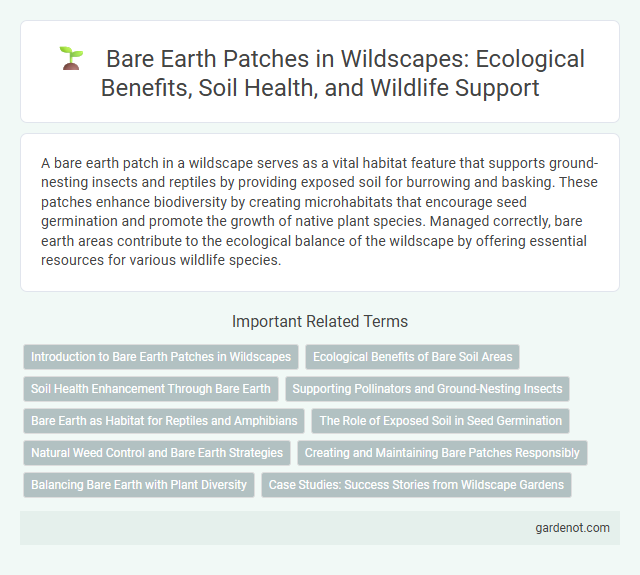A bare earth patch in a wildscape serves as a vital habitat feature that supports ground-nesting insects and reptiles by providing exposed soil for burrowing and basking. These patches enhance biodiversity by creating microhabitats that encourage seed germination and promote the growth of native plant species. Managed correctly, bare earth areas contribute to the ecological balance of the wildscape by offering essential resources for various wildlife species.
Introduction to Bare Earth Patches in Wildscapes
Bare earth patches in wildscapes serve as vital microhabitats, supporting diverse invertebrates such as solitary bees and ground beetles that rely on exposed soil for nesting and foraging. These sunlit, disturbance-created clearings enhance biodiversity by fostering plants adapted to nutrient-poor conditions and providing feeding grounds for reptiles and amphibians sensitive to ground temperature. Integrating bare earth patches into conservation areas promotes ecological balance by maintaining species dependent on open soil environments within complex natural landscapes.
Ecological Benefits of Bare Soil Areas
Bare earth patches in wildscapes provide essential ecological benefits by supporting seed germination and promoting biodiversity through the creation of microhabitats for insects and small ground-dwelling organisms. These soil areas facilitate nutrient cycling and water infiltration, enhancing soil health and stability in natural ecosystems. Maintaining bare soil patches helps preserve native plant communities and supports the intricate food web dynamics crucial for ecosystem resilience.
Soil Health Enhancement Through Bare Earth
Bare earth patches play a crucial role in soil health enhancement by allowing natural processes such as microbial activity and nutrient cycling to restore soil fertility. Exposed soil surfaces encourage the breakdown of organic matter and improve aeration, fostering a richer, more diverse soil ecosystem. These bare patches support the regeneration of native vegetation, promoting long-term sustainability in wildscape environments.
Supporting Pollinators and Ground-Nesting Insects
Bare earth patches provide essential nesting sites for ground-nesting insects such as solitary bees and wasps, promoting biodiversity within wildscapes. These exposed soil areas enable pollinators to lay eggs and burrow, supporting their life cycles and enhancing local pollination services. Maintaining and creating bare earth microhabitats contributes to healthy ecosystems by fostering pollinator populations critical for plant reproduction.
Bare Earth as Habitat for Reptiles and Amphibians
Bare earth patches provide critical habitats for reptiles and amphibians by offering basking sites essential for thermoregulation and access to warm soils for egg-laying. These open areas support diverse invertebrate populations that serve as food sources, enhancing the survival rates of species like lizards, snakes, and frogs. Maintaining bare earth habitats within wildscapes promotes biodiversity and sustains healthy populations of cold-blooded vertebrates.
The Role of Exposed Soil in Seed Germination
Bare earth patches create ideal conditions for seed germination by providing exposed soil that facilitates direct contact between seeds and the ground, enhancing moisture absorption and temperature regulation essential for sprouting. These open areas reduce competition from established vegetation, allowing emerging seedlings greater access to sunlight and nutrients critical for early growth. Exposed soil also supports seed dispersal and microhabitat diversity, promoting biodiversity within wildscape ecosystems.
Natural Weed Control and Bare Earth Strategies
Bare earth patches play a crucial role in natural weed control by limiting the establishment of invasive species and promoting native plant growth through strategic disturbance. Implementing bare earth strategies such as targeted soil exposure and regular disturbance can suppress competitive weeds and encourage biodiversity. Monitoring soil conditions and adjusting management practices enhance the effectiveness of these natural weed control methods in wildscape restoration.
Creating and Maintaining Bare Patches Responsibly
Creating and maintaining bare earth patches in a wildscape enhances biodiversity by providing essential habitats for ground-nesting insects and reptiles. Responsible management involves regular monitoring to prevent erosion, controlling invasive species, and ensuring soil compaction is minimized to preserve natural texture and moisture levels. Implementing sustainable practices such as seasonal disturbance and limited foot traffic supports the ecological balance and promotes native flora regeneration.
Balancing Bare Earth with Plant Diversity
Balancing bare earth patches with plant diversity enhances ecosystem resilience by providing essential habitats for invertebrates and ground-nesting birds while preventing soil erosion. Integrating native ground covers, grasses, and wildflowers around bare areas supports a dynamic interplay between open ground and vegetation. This approach fosters biodiversity, promotes nutrient cycling, and maintains the natural processes crucial for a sustainable wildscape habitat.
Case Studies: Success Stories from Wildscape Gardens
Bare earth patches in Wildscape gardens reveal critical habitats for native species, demonstrating increased biodiversity through targeted restoration efforts. Case studies document rapid colonization by pollinators and ground-nesting birds, illustrating the ecological value of exposed soil in these ecosystems. Wildscape project data confirm that maintaining bare earth areas enhances species richness and supports ecosystem resilience over time.
Bare earth patch Infographic

 gardenot.com
gardenot.com